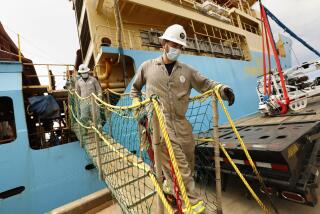Undersea Volcano Erupts on Cue for Startled Scientists on Research Ship
- Share via
A rare underwater volcano in the South Pacific erupted only 130 feet beneath a San Diego-based research ship Sunday, enveloping the vessel in a swirling tumult of murky water, gas bubbles and hot volcanic rocks.
The eruption of the MacDonald Seamount 650 miles southeast of Tahiti sent gas-infused rocks clattering and clanging against the steel hull of the Melville and transformed the greenish ocean water into a churning, boiling dark brown, according to an account by scientists aboard the ship.
“Large gas and steam bubbles burst at the surface with chocolate colored water and, best of all, steaming lava balls too hot to hold in bare hands,” Harmon Craig, the chief scientist, radioed back to his home base Monday in a weekly report.
The eruption, which coincided with the scientists’ arrival to study volcanic activity in the general area, left the the boat rocking and ringing with “horrendous clangs and clamors” but apparently undamaged.
Oceanographers on Wednesday described the experience as “an extraordinary stroke of luck” and apparently the first time anyone has witnessed the kind of underwater volcanic activity believed to influence the little-understood ocean’s currents, chemistry and life.
While geothermal gases are often vented through cracks in the ocean floor, it is extremely unusual for them to be spewed into the fertile, life-filled upper ocean, said Stephen Riser, a University of Washington oceanographer who is to join the expedition next week.
“I think it’s fair to say that nobody has ever seen anything like this before,” Riser said. “As to whether it’s truly significant on some sort of a global scale, or whether it’s a curiosity, that I’m not really sure of yet and I don’t think anybody else is either.”
“This is one of the most unexplored portions of the world’s oceans,” Riser said. “ . . . It’s just an amazing thing to think about sitting there in a ship and seeing rocks coming out of the water.”
Craig, a professor at Scripps Institution of Oceanography of the University of California, San Diego, who specializes in the chemistry of the earth’s crust, is leading the first leg of a federally funded, four-month expedition to study volcanism and its effects on the Pacific Ocean.
Much of his work entails measuring concentrations of helium isotopes in water coming from vents in the sea floor. Created where the floor is shifting, the vents release gases and volcanic material believed to affect ocean circulation and ultimately, the weather.
“The purpose of this expedition was to investigate volcanism,” said Riser, who is to take over next week as the project’s chief scientist. “So it appears to me they found exactly what they were looking for, although they had no idea they were going to find it.”
According to his weekly report, transmitted to Scripps in La Jolla on high-frequency radio, Craig and the crew of several dozen on the 245-foot ship had begun taking samples of ocean water with a measuring device called a hydrocast when the eruption occurred.
“We found large patches of greenish-brown water over the summit on arrival,” he said in his weekly report. “Immediately after the first hydrocast into this discolored water, MacDonald erupted under us.”
In a radio-telephone interview Tuesday, Craig told the New York Times that one giant bubble rose to six feet above the surface of the ocean and then burst, ejecting jets of gas and 20 to 30 volcanic rocks. He said the rocks, buoyed by gas, floated briefly in the air.
Craig said it appeared to be too risky to lower a small boat into the water to explore more closely, but the crew was able to move the ship close enough to enable Craig to net one floating rock that proved to be as big as a football.
Craig could not be reached by radio Wednesday, Scripps officials said.
In his weekly report, Craig said the eruption seemed to explain the origin of seismic and acoustic waves long observed by French seismologists at South Pacific stations. Scientists had previously detected a certain “noise signature” coming from the area, Riser said.
“It’s not surprising that there is volcanic activity in the area,” said Riser, an assistant professor at the University of Washington in Seattle. “What is really amazing and new here is to see the rocks spewing out of the water.”
Extraordinary Place
Riser described the area of the South Pacific as an extraordinary place where the underwater mountain rises to within 130 feet of the surface from an ocean floor nearly two miles deep. He said he knows of no other mountain rising so close to a sea’s surface.
“These mountains spew forth gas . . . that can get into the sea and influence life in the sea,” Riser said. “Ordinarily, it would be at the sea floor, where there is not much life. The interesting thing here is that it’s spewing the stuff into the upper ocean where all the life is.”
He said it is impossible to say whether eruptions of the MacDonald Seamount could affect sea life beyond the immediate area, or whether any effect they might have would be harmful or detrimental.
“I think it’s very interesting and I don’t think we know anything about the implications,” Riser said.
More to Read
Sign up for Essential California
The most important California stories and recommendations in your inbox every morning.
You may occasionally receive promotional content from the Los Angeles Times.













